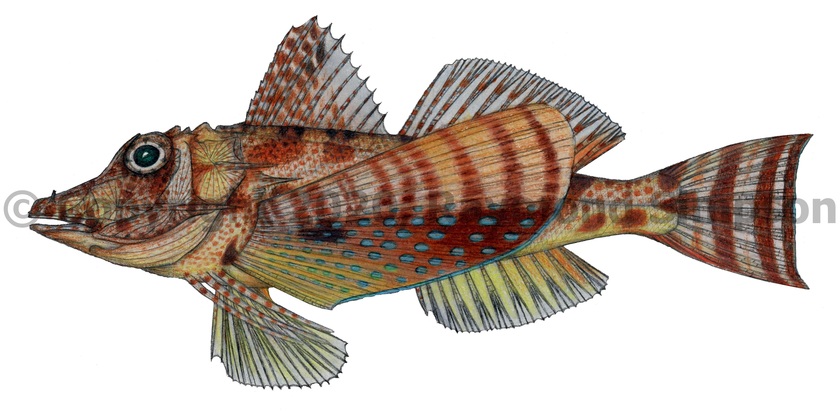
Common Name
Bluespotted Searobin
Year Described
Jordan & Evermann, 1887
Identification
Dorsal Fin: X, 12
Anal Fin: 10
Pectoral Fin: 13-14
Body relatively stout but elongate and slightly compressed . Head is large, bony, and heavily sculptured with pronounced ridges and spines. Head relatively deep. Duck-billed snout is relatively short. Mouth is subterminal and small in size, containing bands of villiform teeth on the jaws, vomer, and palatines. Jaw is well short of eye. No spines at nostrils. Preopercle and opercle usually bear strong spines. Preopercular spine reaches edge of opercle. Large, fan-like pectoral fins with strongly branched rays, with the lower three rays free, thickened, and separate from the fin membrane. Pectoral fin viewed from above squared off anteriorly and broadly rounded posteriorly. Pectorals when folded reach rear end of anal fin base. Two dorsal fins: one spiny and one soft rays. Anal fin opposite soft dorsal fin. Caudal fin is truncate. Pelvic fin underneath pectoral fin on belly. Body covered in small ctenoid scales with the exception of the naked ventral surface. Nape scaled. Opercular membrane above spine partially scaled. Lateral line is continuous.
Color
Body variably colored in shades of brown. Usually pale with variably sized brown or reddish spots and blotches. Can display oblique brown bands made of larger and darker blotches and spots (most obvious under spiny and rear of soft dorsal). Flanks with more regular sized reddish spots over pale background. Belly pale. Head heavily mottled with brown and usually displays a dark eyeband between and under eyes. Dorsal fins mottled brown with dark spots long rays and spines. Spiny dorsal usually with a non-ocellated dark spot between 3rd and 5th spine. Pectoral fin yellow to reddish brown with whitish or pale yellowish crossbanding on the posterior third and base of fin. Rest of fin, especially median area, with striking blue and turquoise spots and fin margin. A black blotch usually present on middle of basal third of fin. Free pectoral rays with red bands. Anal and pelvic fins pale blue to yellow with reddish rays. Caudal fin with two reddish or brown crossbands.
Size
Maximum size to 20cm SL
Habitat
Soft bottoms from 9-262m (usually 27-91m).
Range
Continental from North Carolina to the Yucatan Peninsula, and Panama to S. Brazil.
References
Carvalho-Filho, A. 2023. Fishes of the Brazilian coast. Literare Books International, São Paulo: 1-424.
McEachran, J. D. & J. D. Fechhelm. 2005. Fishes of the Gulf of Mexico. Volume 2: Scorpaeniformes to Tetraodontiformes. University of Texas Press, Austin. i-viii +1-1004.
Richards, W. J. & G. C. Miller. 2003. Triglidae (pp. 1266-1277). In: Carpenter, K. E. (ed.) 2003. The living marine resources of the Western Central Atlantic. Volume 2: Bony fishes part 1 (Acipenseridae to Grammatidae). FAO species identification guide for fishery purposes and American Society of Ichthyologist and Herpetologists Special Publication No. 5. FAO, Rome. v. 2: i-vii + 602-1373.
Other Notes
The only W. Atlantic searobin with a strong mottled brown coloration and blue spots on the pectoral fins.